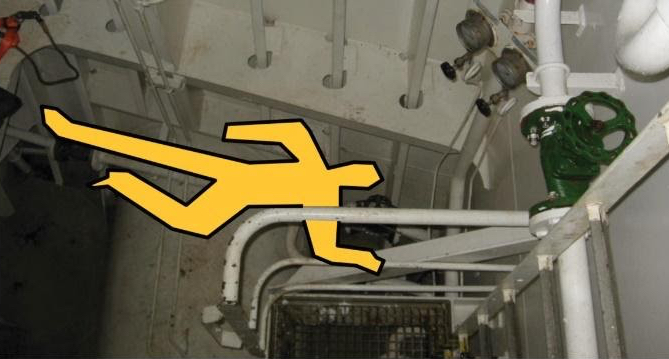Some spaces, although not officially an enclosed space, can still act as one. In a recent Mars Report, a crew member died after entering a bow thruster compartment alone. The Nautical Institute stresses rescue operations should always be conducted with breathing apparatus.
The Nautical Institute gathers reports of maritime accidents and near-misses. It then publishes these so-called Mars Reports (anonymously) to prevent other accidents from happening. A summary of this incident:
A tanker had discharged cargo and crew were ballasting at berth in preparation for departure and a voyage in ballast. During ballasting, the bilge high level alarm sounded for the bow thruster compartment and a crew member was sent forward to investigate. Proceeding down to the bosun’s store level, he immediately noticed water escaping from the forepeak tank manhole. This water had reached the bow thruster compartment entrance and was flowing over the sill plate and cascading on the bow thruster motor below.
The situation was reported to senior officers and the ballasting operation was stopped. The ship’s electrician was to inspect the bow thruster motor for any water damage. The bow thruster’s electrical supply was isolated and two crew members made their way to the bow thruster compartment for the initial assessment of the condition. The motor was sprayed with electrical cleaner and then the workers exited the space for coffee break.
Sometime later the electrician returned alone to continue the work on the bow thruster motor. The second crew member arrived about fifteen minutes later. He saw the electrician lying face down in the bow thruster compartment. He called out to him, but there was no response.
He initiated the emergency response and the master and others soon arrived on scene. The master climbed down to the victim, who remained unresponsive. He then had to exit due to the strong smell of chemicals.
In the meantime, the ship’s rescue team had mustered. They donned breathing apparatus (BA) sets and climbed down into the bow thruster compartment. It then became evident that it would not be possible to recover the electrician from the bow thruster space so the local Civil Protection Department was called to assist. About one hour after first being discovered, the electrician was recovered from the space. However, he was subsequently pronounced dead.
Advice from The Nautical Institute
- Some spaces, although not officially an enclosed space, can assume those same dangerous characteristics if certain conditions are present, especially lack of air circulation.
- NEVER rush into a space that has a collapsed crew member inside. Muster the emergency team and enter with BAs.
- Practice confined space emergency procedures on a variety of compartments on your ship to determine which ones will be problematic.
Picture: Representation of victim in bow thruster compartment.
Mars Reports
This accident was covered in the Mars Reports, originally published as Mars 202058, that are part of Report Number 336. A selection of this Report has also been published in SWZ|Maritime’s November 2020 issue. The Nautical Institute compiles these reports to help prevent maritime accidents. That is why they are also published on SWZ|Maritime’s website.
More reports are needed to keep the scheme interesting and informative. All reports are read only by the Mars coordinator and are treated in the strictest confidence. To submit a report, please use the Mars report form.








